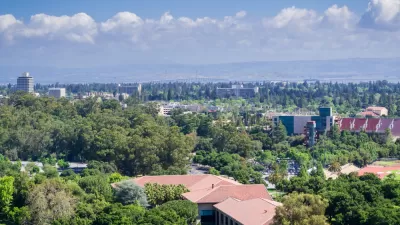Noting the Bay Area's relatively slow growth rate over the past two decades, Timothy B. Lee argues that the area's "bad housing policies" are harming business growth and investment opportunities in Silicon Valley.
Commenting on a recent article in Wired exploring the increasingly unfavorable market for investment in Silicon Valley, Lee ponders what is responsible for suppressing the "natural resources of the startup world" - people, real estate, and support services - noted in the article. He locates the root of the problem in the area's growth management policies.
"Probably the most important reason, as Ryan Avent has pointed out, is that housing regulations make it impossible to build a significant number of new housing units. A variety of regulations-minimum lot sizes, maximum building heights, parking mandates, restrictions on renting out basements, and so forth-place an upper bound on the number of units of housing that can be built in any given municipality in the Bay Area. And developers have simply run out of new places to build that are within a reasonable commuting distance of Silicon Valley or San Francisco"
Noting that since 1990, the population of the Bay Area has grown by less than 20 percent (less than the growth rate for the country as a whole), Lee argues that based on "more reasonable" benchmarks for growth ("Atlanta, Phoenix, or Las Vegas, all of which roughly doubled in size in the last 20 years"), the Bay Area should have 11 million residents, rather than its current 7 million population.
"Among those extra 4 million people would likely have been hundreds of thousands of additional engineers starting new firms or expanding the Google and Facebook workforces. In short, the reason there's too much money chasing too few businesses isn't that the country is running out of people with good technology ideas. It's just that bad housing policies mean that there's nowhere for additional people to live"
FULL STORY: Why The Bay Area Should Have 11 Million Residents Today

Alabama: Trump Terminates Settlements for Black Communities Harmed By Raw Sewage
Trump deemed the landmark civil rights agreement “illegal DEI and environmental justice policy.”

Planetizen Federal Action Tracker
A weekly monitor of how Trump’s orders and actions are impacting planners and planning in America.

The 120 Year Old Tiny Home Villages That Sheltered San Francisco’s Earthquake Refugees
More than a century ago, San Francisco mobilized to house thousands of residents displaced by the 1906 earthquake. Could their strategy offer a model for the present?

LA’s Tree Emergency Goes Beyond Vandalism
After a vandal destroyed dozens of downtown LA trees, Mayor Karen Bass vowed to replace them. Days later, she slashed the city’s tree budget.

Sacramento Leads Nation With Bus-Mounted Bike Lane Enforcement Cameras
The city is the first to use its bus-mounted traffic enforcement system to cite drivers who park or drive in bike lanes.

Seattle Voters Approve Social Housing Referendum
Voters approved a corporate tax to fund the city’s housing authority despite an opposition campaign funded by Amazon and Microsoft.
Urban Design for Planners 1: Software Tools
This six-course series explores essential urban design concepts using open source software and equips planners with the tools they need to participate fully in the urban design process.
Planning for Universal Design
Learn the tools for implementing Universal Design in planning regulations.
Ada County Highway District
Clanton & Associates, Inc.
Jessamine County Fiscal Court
Institute for Housing and Urban Development Studies (IHS)
City of Grandview
Harvard GSD Executive Education
Toledo-Lucas County Plan Commissions
Salt Lake City
NYU Wagner Graduate School of Public Service





























